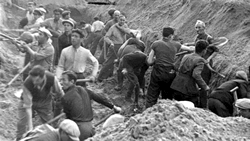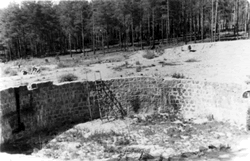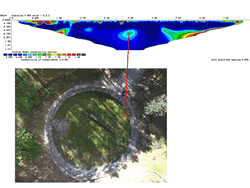Science confirms the incredible story of Lithuania's Holocaust Escape Tunnel https://www.pri.org/stories/2017-04-19/science-confirms-incredible-story-lithuanias-holocaust-escape-tunnel
This story is a part of
PRI's The World
April 19, 2017 · 4:45 PM EDT
By Sarah Birnbaum
Jews digging a trench in Ponar forest, in which they were later buried, after being shot.Credit: Courtesy of Yad Vashem
Every year, the survivors gathered on the last night of Passover to tell the story of their own miraculous escape from bondage to freedom.
Listen to the Story.
Their story doesn’t take place in the desert of Egypt but in the killing pits of Lithuania.
Shortly after the Nazis invaded Lithuania in June 1941, they started bringing groups of Jews from the nearby city of Vilnius, known as the Jerusalem of Lithuania, to the Ponar forest. The Nazis lined them up, shot them at close range, and tossed the bodies into pits.
The unfinished fuel tank site, which was used as an execution site for Jews from the Vilna region.Credit: Courtesy of Yad Vashem
An estimated 100,000 people, including 70,000 Jews, were murdered at Ponar. In 1944, when the Russians were about to retake Lithuania from the Nazis, the Germans recruited a group of 80 Jewish prisoners to exhume the bodies and burn them, in order to hide the evidence.
For months, the prisoners dug up and burned corpses — often they were the bodies of friends or neighbors. One man tells a story of recognizing his wife and children among the dead. Another man washed his hands obsessively for the rest of his life, to remove the trace of the bodies.
The prisoners knew that when they finished their job, they would be shot. So they came up with a plan.
Every night, for 76 nights, they dug a tunnel under the Nazis’ feet. The tunnel went from the burial pit, where they were housed, 100 feet into the forest. They dug the tunnel using spoons and their bare hands.
Then on the last night of Passover, April 15, 1944, the time had come. The prisoners cut off their shackles with a smuggled-in file, and shuffled through the narrow passageway in the ground. When they emerged from the tunnel, the Nazis started shooting. Only 12 prisoners made it out and joined a partisan unit in the forest. Only 11 survived until the end of the war.
The survivors passed their stories down to their children — but the children never knew for certain if the tunnel actually existed.
Until recently.
Last year, an international group of archaeologists found the legendary escape tunnel. They didn’t want to disturb any human remains at the burial pits, so instead of digging, the archaeologists used radar and radio waves to scan beneath the ground. What they found dovetailed exactly with the survivors’ verbal accounts.
This is data from ERT scanning technology, paired with a drone photo of the burning pit. This shows the entrance to the escape tunnel, which was known from prior work at the site, which the archaeology team wanted to confirm. Credit: Paul Bauman/Alistair McClymont
The archaeologists’ discovery is the subject of a new documentary from the program Nova. The co-director of the film, Paula Apsell, says after the archaeologists found the tunnel, the documentary team brought together all the children of the survivors, who live in Israel, and explained the technology to them and showed them the proof.
“You could just see the relief and the closure it brought them,” she says. “They had [their parents’] stories. And of course they believed the stories but they needed the closure. And now they have actually concrete scientific evidence that these stories are true.”
UHart Prof's Discovery Of Holocaust Escape Tunnel Profiled On 'Nova' http://www.courant.com/features/hc-holocaust-escape-tunnel-discovery-on-pbs-20170418-story.html
"Holocaust Escape Tunnel" premieres April 19 at 9 p.m. on PBS.
ROGER CATLIN
Special to The Courant
University of Hartford professor and archaeologist Richard Freund has made some news-making finds before, in projects in Europe and Israel, including what he called the the best guess for the lost city of Atlantis.
But the reaction was nothing like the discovery last year of a long-rumored, long-lost Holocaust tunnel dug with hands and spoons by prisoners fleeing a Nazi burial pit in Lithuania.
ADVERTISING
The discovery in June 2016 sparked headlines worldwide and may point to a different process of finding mass graves in the future. Cameras from the long-running PBS science program "Nova" were there when the discovery was made last June; the resulting episode, "Holocaust Escape Tunnel" premieres April 19 at 9 p.m. on PBS.
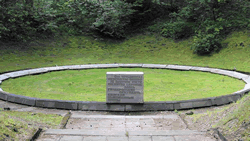
This memorial marks one of the smaller burial pits found at the Lithuanian site Ponar, where thousands were killed and their bodies dumped during the Holocaust. (Ezra Wolfinger for NOVA)
Freund says his team went to Lithuania to research something completely different — the lost Great Synagogue of Vilna, itself a lost Jewish city within the present capital of Vilnius that was destroyed by Nazis.
While there with its unique equipment — noninvasive subsurface mapping technology that uses electrical resistivity tomography, lent by a Canadian gas and oil company — Freund and his team from the University of Hartford did find a substantial portion of the historic synagogue, which Paula Apsell, senior executive producer of "Nova", says was "so magnificent even Napoleon was in awe at the sight."
It would have been newsworthy on its own, but while in Lithuania, Freund asked whether there were other underground projects that could use their unique methods.
"The Vilna Gaon Jewish State Museum there said, 'We have two problems: Ponar, this forest has 100,000 people who were buried there. We don't know where all the burial pits are. It's just a forest. Can you help us find the burial pits?'" Freund says.
"Also, they asked, 'Can you help us to see if it's possible to find this legendary missing tunnel?'"
They set up the equipment, using pins on the forest floor to detect aberrations below.
"We found the burial pit that was 72 feet long and 12 feet deep that had 7,000 people in it," Freund says.
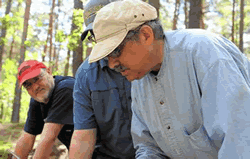
University of Hartford professor and archaeologist Richard Freund (in tan hat) discusses excavation work as cameras from the long-running PBS science program “Nova” film. Nova crews were present when the hidden tunnel discovery was made last June. (Ezra Wolfinger for NOVA)
There had been firsthand accounts written about the tunnel, Freund says, "from 11 that survived the war and actually wrote up their testimonies on this tunnel, and they basically had the same elements — from this one single pit where they were housing all of these 80 Jews that were basically the burning brigade."
It's a horrific story that predates death camps and gas chambers of World War II. Ten days after the the Nazis invaded Lithuania in June 1941, the first groups of Jews were sent to the Ponar forest just outside town and shot. Some 70,000 Jews and 30,000 other suspected undesirables were believed to have been shot and thrown into pits.
Yale history professor Timothy Snyder, who appears in the film, says this "Holocaust by bullets" was crucial in that it's what convinced Nazis that an even wider genocide was possible.
But as the Soviet army approached to retake Lithuania in 1944, Nazis scrambled to cover up their mass murder. They assembled 80 Jewish prisoners to dig up and burn the bodies.
"It's important to know that these 80 men — 76 men and four women — in the burning brigade were unearthing bodies of their wives, their parents, their uncles, their children," says episode director Kirk Wolfinger. "We have several accounts where people would uncover them."
Says Abe Gol, son of one of the 11 survivors, "My father found one of his brothers as they were unearthing bodies."
Miracle Find
The brigade knew that when their ugly task was done, they'd also be killed. So after their back-breaking work during the day, by night they dug a 100-foot-long escape tunnel with their hands and any tools they could find from the bodies they uncovered during the day, such as spoons. The work continued for 76 nights.
On April 15, 1944, the last night of Passover, a dozen members of the brigade managed to escape and 11 survived to tell the story.
Sixty years later, the entrance of the fabled tunnel had been found in 2004 by Lithuanian archeologists, but nothing else.
Because they didn't want to disturb the bodies of the mass grave, Freund says, those archeologists "couldn't do anything but indicate where it started.
"They couldn't figure out how to actually trace something that's 20 feet below the surface in the midst of burial pits," he said. "That's where our technology came in."
The discovery soon eclipsed the reason the "Nova" cameras were there in the first place, Wolfinger says. "It was an incredible surprise, which was picked up by the news around the world, and thanks to Dr. Freund and his technology."
Freund says it's "a perfect example of why noninvasive archeology can solve so many problems without having to keep digging up places and violating the victims' last resting place."
The find, he says, was "so amazing, so improbable — and that 'Nova' was there was really a tremendous bonus."
"What you saw on the clip was genuine surprise among these scientists, that they had actually managed to hit something so historic and so fortunate and so personally meaningful," Apsell says. "It was just a great moment to be able to capture."
And it was important for history as well, she says. "People ask, 'Well, you have all these stories, so what do you need to find the tunnel for?'"
Apsell cites the 2016 film "Denial," depicting Emory University scholar Deborah Lipstadt standing up to a Holocaust denier.
"Memories fade," she says, "but scientific proof does not."
When someone on the internet attempts to deny the existence of the tunnel, Apsell says, "this proof is really necessary. And that's why I'm so glad that 'Nova' can provide it."
Freund says the discovery may inspire young people as well.
"Most of the work is being done by 18- to 22-year-olds in the field, Jews and non Jews," he says of his University of Hartford team. "These are students that are not going to become archeologists, but I have to say the impact of working in the field for these millennials is so enormously powerful that this kind of movie is going to make an enormous impact upon that generation to inspire them about what you can learn about history in a different way than opening books."
NOVA: HOLOCAUST ESCAPE TUNNEL premieres Wednesday, April 19, at 9 p.m. on PBS, locally on CPTV.
